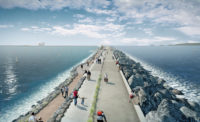
The Dynamic Tidal Power dam will exploit currents running parallel to shore to produce energy.
Exploration and production teams travel to the ends of the Earth searching for energy to power the world’s growing economies. But a pair of Dutch engineers has discovered a new form of energy in the tides off their own country, and they are leading an elite team of companies in a program to find and exploit opportunities for it worldwide. They have patented the technology and call it Dynamic Tidal Power.
 |
DTP aims to tap the energy of tidal flow to generate electricity. “We call it the third way to exploit tidal power,” says Kees Hulsbergen, owner of consultancy Hulsbergen Hydraulic innovation & Design (H2iD). Historically, only two ways have been tried: tidal barrages and tidal stream or free-flow generators. Hulsbergen and Rob Steijn, now director River, Coast and Sea Dept., ARCADIS Nederland BV, hatched their third way in 1996, when both were senior researchers at Delft Hydraulics in the Netherlands. Now it is the focus of a Dutch-Chinese program to assess the feasibility of constructing the first DTP project on the Chinese coast near Shantou, Guangdong.
“It’s a completely new source of energy,” says Steijn. “It’s based on Newton’s second law. It uses the acceleration force that is inherent in tidal movement.”
DTP involves building a dam-like structure perpendicular to the coast in a shallow sea to capture the energy of tidal flows running parallel to the shore. The dam is made of 100-meter-long precast caisson sections with embedded bi-directional hydroturbines. The dam’s only abutment is on the shore; the seaward end is free, or it may be capped with a coast-parallel barrier forming a large “T”.
As the alongshore tidal flow washes against the dam, it creates differences in water levels—hydraulic head—on the opposite sides of the dam. Channeled through the turbine penetrations in the dam, the head drives the turbines to generate electricity. When the tide shifts, the runner blades swivel in place 180 degrees on the turbine to receive the reversed flow.
Although DTP was patented in 1997, no DTP project has been built because it requires a site with specific characteristics and it must be built on a massive scale to be economically feasible. That’s mainly because of the very low head resulting from the languid tidal flow.
“If you have built hydropower dams on rivers, and you see the flow force on the shoreline, which is often less than 1 meter per second (1 m/s), the hydraulic head that you would expect if you are a river engineer is just a few centimeters,” says Steijn. “We were a little bit worried when we found that the concept works on a tidal prospectus with just a few meters of hydraulic head, while other hydropower works with much higher hydraulic heads.” Steijn and Hulsbergen discussed the matter with Jacob Arnold, the chief scientist at pump manufacturer Pentair Nijhuis BV, who showed them that a turbine generator his company makes can produce electricity with as little as 20 cm of head.
Getting enough energy from the low head to generate electricity was the next problem to solve. “The total potential power that is physically present in the water level difference over the two sides of the dam grows with the length of the dam to the power of 2.5,” Hulsbergen explains. “If we call the dam length L, the basic formula here is that the installed power, P, is L2.5, exponentially, which means if you double the dam length, L, the power that can be installed grows with a factor of about 5.5.”
A dam 5-10 km long would successfully produce electricity from the tidal energy, but economically it would not work, Hulsbergen says. “Roughly, you must think of minimum dam length on the order of 20-25 km.” The Chinese built their own tidal model, instructed by Hulsbergen and Steijn. From about 40 potential sites, the Chinese narrowed their choice down to a single 100-km-long dam in an area with a maximum water depth of 30 m. For every dam, the foundation design will depend on the nature of the seabed. The Chinese are now doing geotechnical studies. If the seabed is firm, the dam will simply rest on the seabed.
Starting about 20 km from the shore and for the next 40 km, average depth is 22 m. The depth beyond that, in the outermost 40 km, averages 12 m. The total turbine count has not yet been established, but current plans call for 3,000 turbines, mainly in the deeper part of the dam. Turbines will be dual-bladed, bi-directional, low-head, high-output, 8 m dia., 3.5 MW each. The hydraulic head will be 1.5-2 m and the flow 4.5 m/s.


Post a comment to this article
Report Abusive Comment